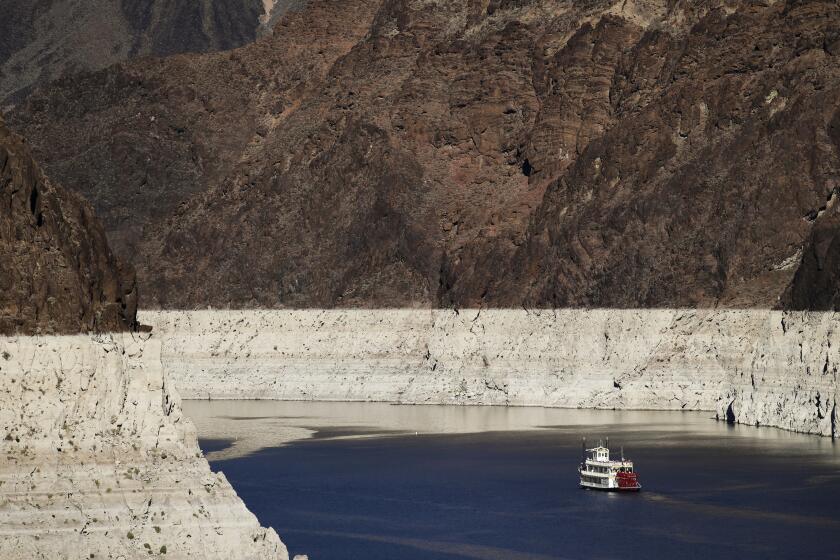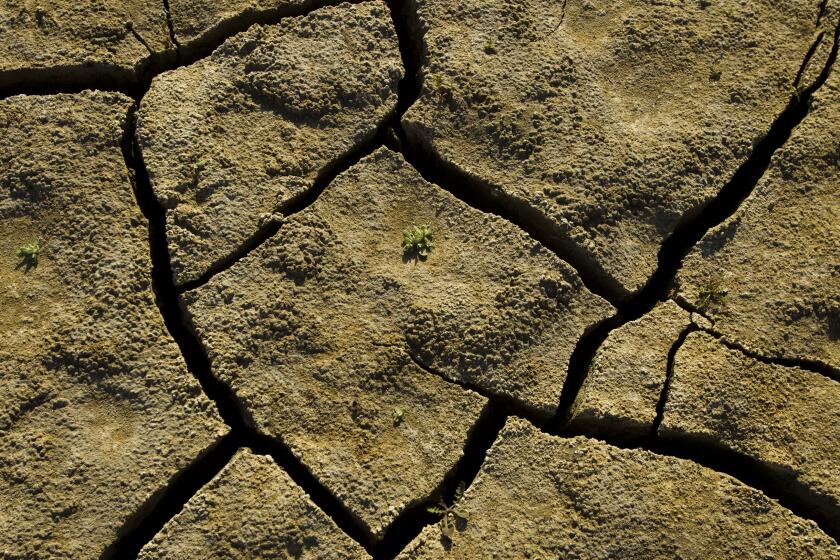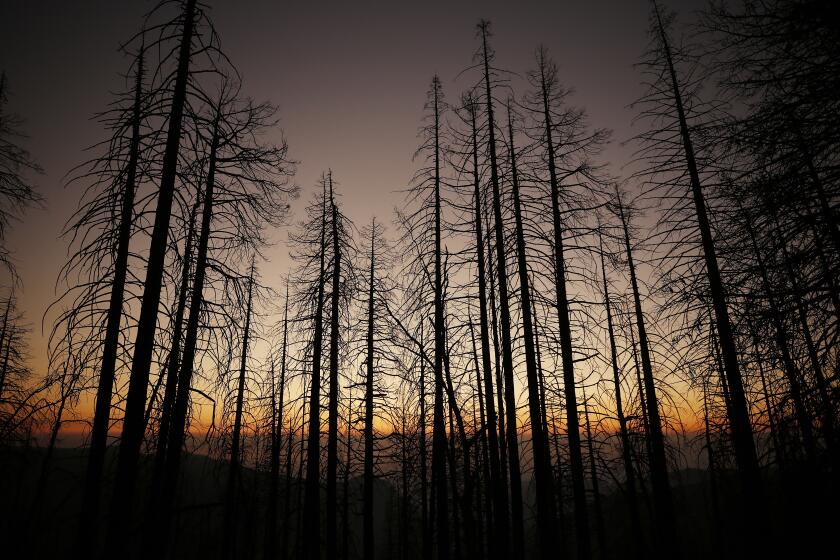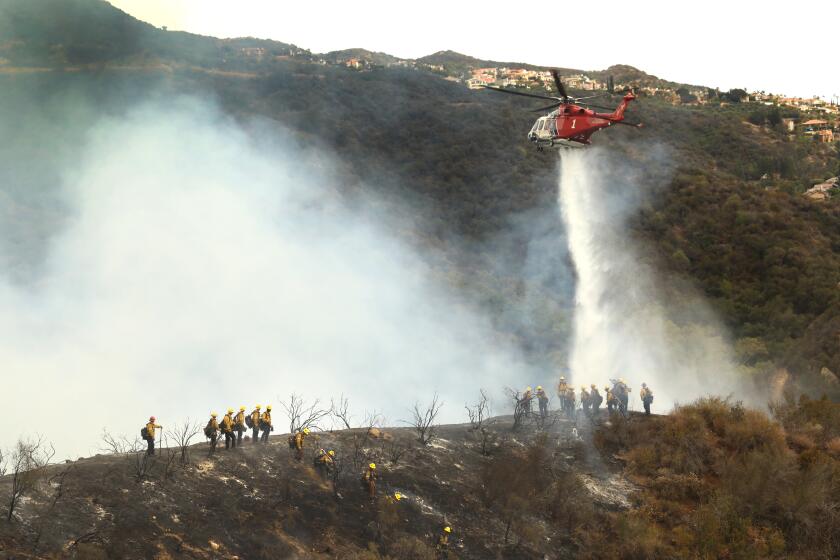California’s drought and wildfire dangers rising at stunning pace
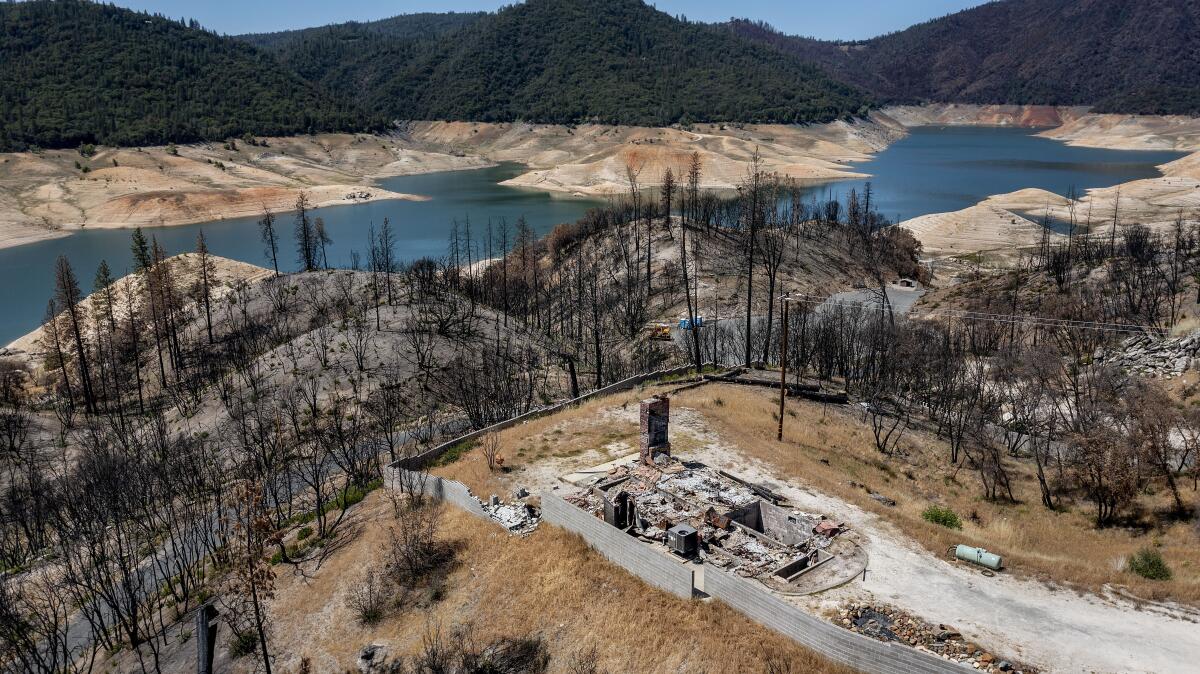
- Share via
California’s drought and wildfire conditions are accelerating at unprecedented rates, according to state officials, and residents should brace for a summer of widespread burning and mandatory water conservation measures in some regions.
As reservoir levels across the state continue to drop, and as parched vegetation poses an increasing threat of wildfire, officials in Sacramento and Southern California offered a bleak assessment of the state’s drying climate, saying it has already begun to affect people, plants and animals.
The current drought, which blankets the entire state and a broad swath of the western United States, according to the U.S. Drought Monitor, is already outpacing the state’s devastating 2012-16 drought, said Karla Nemeth, director of the California Department of Water Resources.
“It really wasn’t until year three or four when we saw these intense conditions … we’re now experiencing in the second year of the drought,” Nemeth said Friday. “That acceleration is really what’s new about this drought and what we’re working to respond to.”
California typically relies on the gradual melting of Sierra snowpack to fill its reservoirs, Nemeth said. But this year, the state saw record evaporation and record low runoff into streams and reservoirs.
It is “unprecedented in the breadth and severity of this regional drought,” said Wade Crowfoot, secretary of the state’s Natural Resources Agency.
There’s a drought in the West. Here’s what you need to know about climate change, heat waves, wildfires, and more.
At the same time, fire officials in Southern California warned that wildfire conditions are already like those typically seen in August and September.
“We’re seeing fires move fast,” said Chief Brian Fennessy of the Orange County Fire Authority. “Fires that normally would be an acre, 2 acres, 5 acres, so far this year are getting to 30, 50 and beyond.”
They’re also spreading more quickly, he said.
“We are seeing fire spread that is even stunning many of us that have been doing this for a very long time — fire spread that could quite easily surprise many of the citizens within this region,” he said. He urged people to evacuate as soon as they’re told to do so.
These dry conditions do not bode well for the Fourth of July weekend, when first responders will probably face their first big test as a predicted heat wave collides with amateur fireworks displays.
Last month, Gov. Gavin Newsom expanded a drought emergency to 41 California counties, covering 30% of the state’s population. On Friday, Santa Clara County declared its own local emergency, saying drought conditions were so extreme that water levels were not adequate to meet demand.
“The reality is we live in an arid region that will continue to experience droughts,” Jasneet Sharma, director of Santa Clara County’s Office of Sustainability, said in a statement. “There are many steps that we should all take, from large-scale conservation projects and household-level water conservation retrofits to simple household changes like turning off the faucet when you brush your teeth. Each one is an important part of sustainability.”
California has entered another drought. But depending on who you ask, the last one may have never really ended.
Water conservation is likely to ramp up, possibly becoming mandatory in some communities, said Joaquin Esquivel, chair of the State Water Resources Control Board.
“It’s not about conservation just because it’s drought. … We really need to see conservation and efficiency here as just [a] simple course of action that we must do, no matter if it’s dry or it’s wet,” Esquivel said.
This year’s parched conditions are already causing concern, especially after a heat wave swept across Southern California this month, breaking several records and heating Palm Springs to 123 degrees.
Usually the natural world can adapt to gradual changes in the climate, but California’s conditions are changing so frequently that plants and animals are not able to keep up, said Chuck Bonham, director of California’s Department of Fish and Wildlife.
“They don’t have the luxury of adapting over millennia anymore; they’re being forced to adapt over a period of years,” he said.
The decrease in water levels has caused some rivers to heat up, becoming uninhabitable for some fish. Department of Fish and Wildlife teams recently removed almost 17 million Chinook salmon from four hatcheries in the Central Valley and released them into the ocean at places such as San Francisco Bay. The number of fish rescues has increased since the previous drought, Bonham said.
“We also know we’re going to end up serving as a Noah’s Ark,” he added, referring to a menagerie of animals kept at UC Davis until their environments become cool enough to live in again. “Every drop of water we can save as Californians is going to matter for people, but it’s going to matter for nature too.”
The drying also carries severe consequences for wildfire.
On Friday, fire officials gathered outside a Los Angeles County fire station in La Cañada Flintridge and said the heightened fire conditions were due to drought and unseasonably warm temperatures. Scientists say that climate change has driven the shifts by creating hotter, drier weather interspersed with more extreme, erratic precipitation events.
Researchers now believe a wildfire last year killed 10% to 14% of the world’s natural sequoia population.
Live fuel moisture levels, which measure the dryness of vegetation, are on par with those typically seen in the late summer or fall, said Los Angeles County Fire Chief Daryl Osby, who serves as mutual aid coordinator for the region comprising Los Angeles, Orange, San Luis Obispo, Santa Barbara and Ventura counties.
“You saw the fire in L.A. city, the Palisades fire that burned in the fog,” he said, referring to the blaze that forced evacuations in Topanga Canyon in mid-May. “That’s kind of unprecedented, you would think in years past, but it’s the norm now.”
The fire broke out in an area that hadn’t burned in 50 years and that was choked with drought-killed vegetation, he said. Because of the topography and dryness, it grew to more than 1,000 acres before firefighters were able to bring it under control, despite relatively calm winds.
“Our expectations are that during this summer, we’re going to have those types of fires and larger with just the winds off the ocean,” Osby said. “And then we’re really concerned moving into the fall months when we start getting our significant wind-driven fires.”
Officials have taken steps to prepare. When the forecast looks dire — for instance, if the National Weather Service issues a red-flag warning — the California Governor’s Office of Emergency Services works with local jurisdictions to pre-position extra firefighters, engines and aircraft and reimburses the governments for the added cost, said Cal OES Fire and Rescue Chief Brian Marshall.
“That gives us a fighting chance to catch the fires when they’re small,” he said.
Key to that is the prompt use of aircraft, which enables ground crews to then go in and extinguish the fires, Fennessy said. Southern California fire personnel have more aircraft available this year than in years past, including large helitankers that can fly at night, he said.
The California Department of Forestry and Fire Protection moved to peak staffing earlier this year, sooner than normal, and will maintain that level for the rest of the year, said Chief Glenn Barley, assistant region chief for Cal Fire’s Southern Region.
“Last year was the worst fire season we’ve seen in California,” Barley said. “At this point this year, we are ahead of those numbers for last year, both in terms of number of fires and number of acres burned.”
Experts have warned that warmer temperatures, longer and drier droughts and more intense bursts of precipitation have primed the West for a long, active year of fire.
Yet fire officials said that while they’re well resourced, they still don’t have enough, particularly in light of the potentially historic fire season bearing down on the region.
“I will say that from my municipality to the state to the federal government, that we’re stretched. We’re busy,” Osby said, adding that local municipalities still have to go on medical calls — more than 1,000 a day in the case of his department — in addition to fighting fires. “None of us have all the resources that we need.”
He said L.A. County would normally have 24 inmate firefighting crews but is down to eight, as many were sent home from prison after the state granted them early release because of the pandemic. That has forced the department to dip into its budget to train more paid crew members, he said.
Meanwhile, the National Interagency Fire Center this week raised its preparedness level to 4, the second-highest, said Angeles National Forest Fire Chief Robert Garcia.
“The significance of that is that the last time we were in this preparedness Level 4 at this time of year was in 2002,” he said. “And prior to that, the last time was 1991.”
More to Read
Sign up for Essential California
The most important California stories and recommendations in your inbox every morning.
You may occasionally receive promotional content from the Los Angeles Times.
